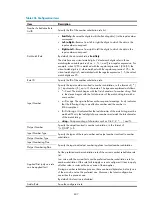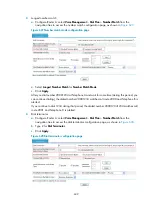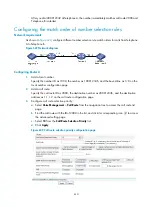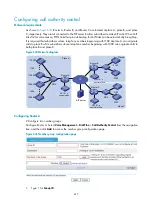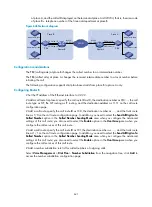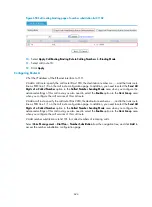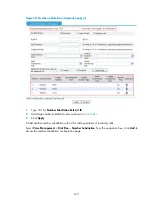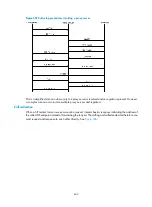
621
at place A, and the caller ID displayed on the terminal at place A is 0211234, that is, the area code
of place B + telephone number of the financial department at place B.
Figure 646
Network diagram
Configuration considerations
The PBX (calling side) at place B changes the called number to an intermediate number.
The PBX (called side) at place A changes the received intermediate number to a local number before
initiating the call.
The following configuration supports dial plan–based calls from place B to place A only.
Configuring Router B
# Set the IP address of the Ethernet interface to 2.2.2.2.
# Add a call route for place A: specify the call route ID as 10, the destination number as 010…., the call
route type as SIP, the SIP routing as IP routing, and the destination address as 1.1.1.1 on the call route
configuration page.
# Add a call route: specify the call route ID as 100, the destination number as ...., and the trunk route
line as 1/0 on the call route configuration page. In addition, you need to select the
Send All Digits of a
Called Number
option in the
Called Number Sending Mode
area when you configure the advanced
settings of this call route; you also need to select the
Enable
option in the
Hunt Group
area when you
configure the call services of this call route.
# Add a call route: specify the call route ID as 101, the destination number as ...., and the trunk route
line as 1/1 on the call route configuration page. In addition, you need to select the
Send All Digits of a
Called Number
option in the
Called Number Sending Mode
area when you configure the advanced
settings of this call route; you also need to select the
Enable
option in the
Hunt Group
area when you
configure the call services of this call route.
# Add a number substitution rule list for called numbers of outgoing calls.
Select
Voice Management
>
Dial Plan
>
Number Substitution
from the navigation tree, click
Add
to
access the number substitution configuration page.
WAN
Financial Dept. 1688
Sales Dept. 2323
Market Dept. 3366
FXO Line 1/1
FXO Line 1/0
PBX
Eth2/1
2.2.2.2/24
Eth2/1
1.1.1.1/24
FXO Line 1/0
FXO Line 1/1
PBX
Market Dept. 6788
Financial Dept. 1234
Sales Dept. 6565
Router A
Router B
Place B
Place A
Содержание MSR SERIES
Страница 17: ...xv Documents 835 Websites 835 Conventions 836 Index 838 ...
Страница 20: ...3 Figure 3 Initial page of the Web interface ...
Страница 42: ...25 Figure 13 Firefox Web browser setting ...
Страница 59: ...42 Figure 27 Checking the basic service configuration ...
Страница 73: ...56 Figure 35 Sample interface statistics ...
Страница 156: ...139 Figure 139 Rebooting the 3G modem ...
Страница 168: ...151 Figure 152 Configuring Web server 2 ...
Страница 174: ...157 Figure 158 Configure the URL filtering function ...
Страница 187: ...170 Upon detecting the Land or Smurf attack on Ethernet 0 2 Router outputs an alarm log and drops the attack packet ...
Страница 242: ...225 Figure 233 Enabling the DHCP client on interface Ethernet 0 1 ...
Страница 247: ...230 Figure 236 The page for configuring an advanced IPv4 ACL ...
Страница 255: ...238 Figure 241 Advanced limit setting ...
Страница 298: ...281 e Click Apply 2 Configure Router B in the same way Router A is configured ...
Страница 354: ...337 Figure 339 Configuring a login control rule so Host B cannot access Router through the Web ...
Страница 400: ...383 Figure 387 Verifying the configuration ...
Страница 405: ...388 ...
Страница 523: ...506 Figure 530 Ping configuration page ...
Страница 538: ...521 a Click Device A on the topology diagram b Click Ethernet 0 2 on the panel diagram c Click Port Guard ...
Страница 744: ...727 Verifying the configuration In the case that the IP network is unavailable calls can be made over PSTN ...
Страница 775: ...758 Figure 785 Configuring a jump node ...
Страница 791: ...774 Figure 801 Configuring a jump node ...

